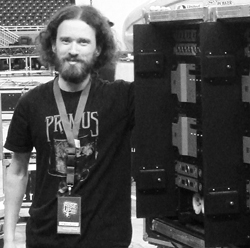
Applying Concepts
It’s also an ethic that has driven his academic work, including the development of modeling programs such as the Virtual Bass Toolbox and FDTD Simulation Toolbox – the latter created while working on his PhD and which has enabled him to do a significant amount of research.
“I specialize in low-frequency sound reproduction and reinforcement, from small rooms to large-scale designs, and needed to simulate low-frequency acoustics accurately in rooms with strange shapes and obstacles,” he explains. “The programs that existed went down to about 63 Hz, but I was working at 20 to 200 Hz. The FDTD Simulation Toolbox addresses these needs, although it’s in serious need of updating right now.”
Additional areas of research include diffuse signal processing (DiSP), low-frequency sound source localization, calibration techniques for cinema subwoofer systems, and chameleon subwoofer arrays (CSA).
Developed as part of his PhD thesis, and covered extensively in an AES paper co-authored with Professor Hawksford, CSA was developed to minimize variations of low-frequency response caused by room-modes in closed spaces. “The idea is that, in its perfect implementation, each subwoofer would have multiple drive units that could be controlled individually, calibrated by measurement at certain points within the room,” he expounds, adding that the technology also works with conventional loudspeakers.
He’s also applied a combination of CSA and DiSP methods to a ground-stacked subwoofer array. “Only in simulations at this point,” he notes, but with an eye to distributing low-frequency energy within the coverage area while dramatically reducing stray energy on stage. “The approach of DiSP is to de-coorelate signal going to each subwoofer by adding a slight amount of phase randomization, not enough to be perceptible but just enough to minimize constructive and destructive interference within the audience. It’s an extension of a similar technique that has been used in the industry for quite a while.”

Keeping It Interesting
To this point in his young career, Hill has authored and co-authored at least 25 papers for leading audio societies and organizations, including more than 10 for the AES. While many of them focus on low-frequency concepts and research, others carry titles such as “Live event performer tracking for digital console automation using industry-standard wireless microphone systems” and “The effect of background music in higher education learning environments.”
And some of his work strays well beyond those norms. For example, there’s a 2014 paper he co-authored entitled “Habitat quality affects sound production and likely distance of detection of coral reefs,” prepared for the Marine Ecology Progress Series.
Coming at the conclusion of our conversation, Hill began chuckling before I even finished reading the title. “When I was in Essex, a friend of a friend was doing his Ph.D in Marine Biology, studying the health of coral reefs,” he explains. “He was interested in whether there was an audio cue that could be used to judge a reef’s health. I applied one of the algorithms used in the Virtual Bass Toolbox to analyze the recordings my colleague made.
“It’s a random application of something I’d already done, but what amazes me is the number of different places this stuff can be applied. You’ve got to talk to people in different disciplines and collaborate. That’s what keeps things interesting.”
Based in Toronto, Kevin Young is a freelance music and tech writer, professional musician and composer.
